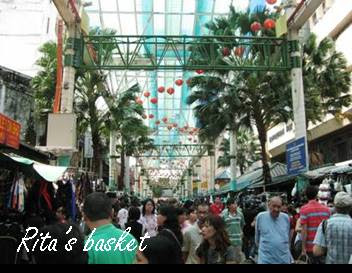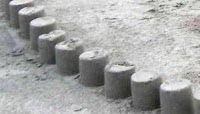Mid-Autumn Festival
>> Sep 30, 2009
A favorite festival of the Chinese, celebrated on the 15th day of the 8th month of Chinese Lunar calendar. This year, it will fall on 3rd October (Saturday). It is also known as Mooncake festival or in Chinese, “Zhongqiu Jie”. Many Chinese around the world celebrate this special day.
There were many legends surrounding the origins of Mid-Autumn Festival and mooncakes. The most popular one tells how a goddess named Chang'er ascended to the moon.
A long, long time ago, a terrible drought plagued the earth. Ten suns burned fiercely in the sky like smoldering volcanoes. The trees and grass were scorched. The land was cracked and parched, and rivers were dried. Many people died of hunger and thirst.
The King of Heaven sent Hou Yi down to the earth to help. When Hou Yi arrived, he took out his red bow and white arrows and shot down nine suns one after another. The weather immediately turned cooler. Heavy rains filled the rivers with fresh water and the grass and trees turned green. Life was restored and humanity was saved.
One day, a charming young woman Chang'er made her way home from a stream, holding a bamboo container. A young man came forward, asking for a drink. When she saw the red bow and white arrows hanging round his belt, Chang'er realized that he was their savior, Hou Yi. Inviting him to drink, Chang'er plucked a beautiful flower and gave it to him as a token of respect. Hou Yi, in turn, selected a beautiful silver fox fur as his gift for her. This meeting kindled the spark of their love. And soon after that, they got married.
A mortal's life is limited, of course. So in order to enjoy his happy life with Chang'er forever, Hou Yi decided to look for an elixir of life. He went to the Kunlun Mountains
Out of respect for the good deeds he had done, the Western Queen Mother rewarded Hou Yi with the elixir, a fine powder made from kernels of fruit which grew on the tree of eternity. At the same time, she told him that if he and his wife shared the elixir, they would both enjoy eternal life; but if only one of them took it, that one would ascend to Heaven and become immortal.
Hou Yi returned home and told his wife all that had happened and they decided to drink the elixir together on the 15th day of the eighth lunar month when the moon was full and bright. A wicked and merciless man named Feng Meng overheard their plan. He wished Hou Yi an early death so that he could drink the elixir himself and become immortal. His opportunity finally arrived. One day, when the full moon is rising, Hou Yi was on his way home from hunting. Feng Meng killed him. The murderer then ran to Hou Yi's home and forced Chang'er to give him the elixir. Without hesitating, Chang'er picked up the elixir and drunk it all.
Overcome with grief, Chang'er rushed to her dead husband's side, weeping bitterly. Soon the elixir began to have its effect and Chang'er felt herself being lifted towards Heaven.
Chang'er decided to live on the moon because it was the nearest to the earth. There she lived a simple and contented life. Even though she was in Heaven, her heart remained in the world of mortals. Never did she forget the deep love she had for Hou Yi and the love she felt for the people who had shared their sadness and happiness. It is said that Chang'er transformed herself into brilliant moonlight and descended to earth to offer good fortune. Thus, couples swear their mutual love under the full moon while separated lovers pray for reunion under the full moon.
Another legend explained the role of the Old Man on the Moon, the Divine Match-maker. The Chinese believed that marriages were made in Heaven but prepared on the moon. The Old Man on the Moon tied the feet of young men and women with red cords for marriages. Thus a maiden made offerings and prayed to him during the Mid-Autumn Festival, hoping that some day she would ride in the red bridal sedan chair.
According to one Chinese folk tale, a Han Chinese rebel leader named Liu Fu Tong devised a scheme to arouse the Han Chinese to rise up against the ruling Mongols to end the oppressive Yuan dynasty. He sought permission from Mongolian leaders to give gifts to friends as a symbolic gesture to honor the longevity of the Mongolian emperor. These gifts were round mooncakes. Inside, Liu had his followers place pieces of paper with the date the Han Chinese were to strike out in rebellion -- on the fifteenth night of the eighth month.
Maybe the Oriental “Trojan Horse story” was true…
Yet another legend, The Hare - Jade Rabbit. In this legend, three fairy sages transformed themselves into pitiful old men and begged for something to eat from a fox, a monkey and a rabbit. The fox and the monkey both had food to give to the old men, but the rabbit, empty-handed, offered his own flesh instead, jumping into a blazing fire to cook himself. The sages were so touched by the rabbit's sacrifice that they let him live in the
Extracted from Chinese Fortune-Telling Calendar
Hmmm…which would you like to believe? :-)
Me, I’m just glad the tradition lives on…
Mooncakes are available here usually 4 weeks before the actual date but I’ve seen some confectionaries selling these traditional delightfully sweet pastries as early as 8 weeks prior to the Festival. They used to fill these pastries with lotus seed paste & melon seeds, green beans (mung-beans), red-beans, some come with single or double salted egg yolks or mixed nuts & candied winter melons and snow-skin mooncake. While traditionalist may balk at the modern versions, creative bakers have recently tempted consumers with fillings like durian, tiramisu, jelly mooncake, Hagen-Dazs ice-cream, dragon-fruits, green-tea, pandan and even mocha flavours.
:-P

Mid-Autumn Festival is the 2nd most important festival after the Chinese New Year. I remembered gathering in my Grandma’s house when I was small. We’ll set up a table under the bright moonlight, enjoying mooncakes, pomelos, baby yam, ngau-kok (it's small about 4cm, looks like buffalo-horns and it’s black in colour) and colourful paper lanterns hanging along the verandah. The children could be seen carrying a lantern each walking around the neighbourhood. That’s life, growing up in a small town.
A nostalgic stroll through Petaling Street 2 weeks ago, we saw some lanterns and mooncakes sold in famous (“lou-qiu pai”, meaning old-brand) confectionaries & cafés. There are some lanterns made of wire & coloured transparent paper in in the shape of dragon and butterfly, contemporary & kids-popular shape of Doraemon, Spiderman, Superman, Ben-10, Hello Kitty.

Now, Grandma is no longer here but we do still carry on the tradition of gathering, but at my Mom’s place. We’ll start with a small feast, my Mom will cook her signature dishes or we’ll have a steam boat session. :-P Last year, we had a small BBQ, some wine and a couple of neigbours dropped in and shared the worshipping of the Moon Goddess with us. My nieces, nephews, cousins and a few kids from the neighbours joined in and it was indeed a fun-time for the kids… it brought back memories of my childhood days.
I’m no longer in my pig-tails but a mama of a little boy… Max got a new lantern made by Daddy over the weekend.
I hope you will have a fun-filled family reunion and enjoy the bright beautiful moon and the many delicacies offered this weekend.
Happy Mid-Autumn Festival! Cheers.
 Read more...
Read more...
Read more!












































































